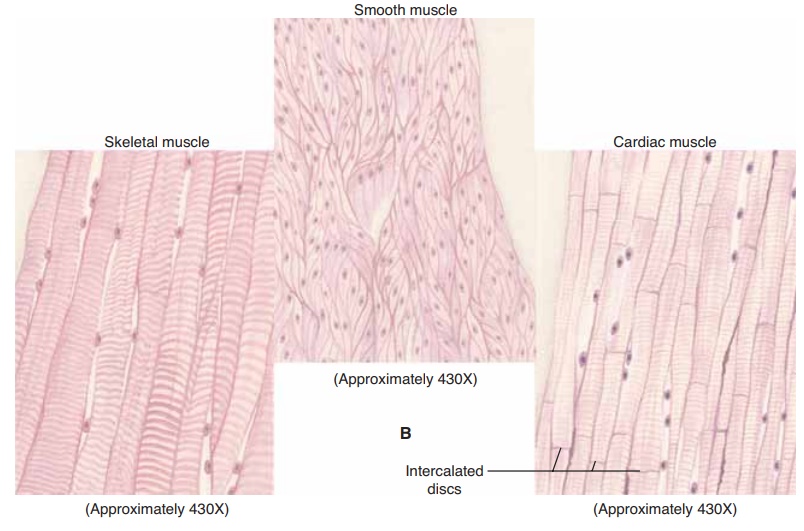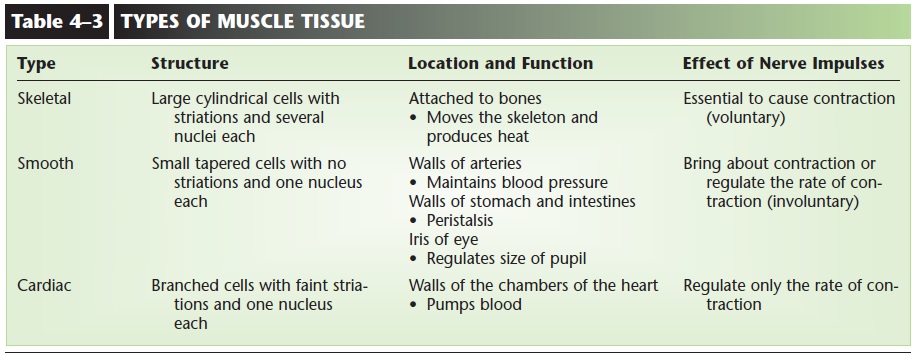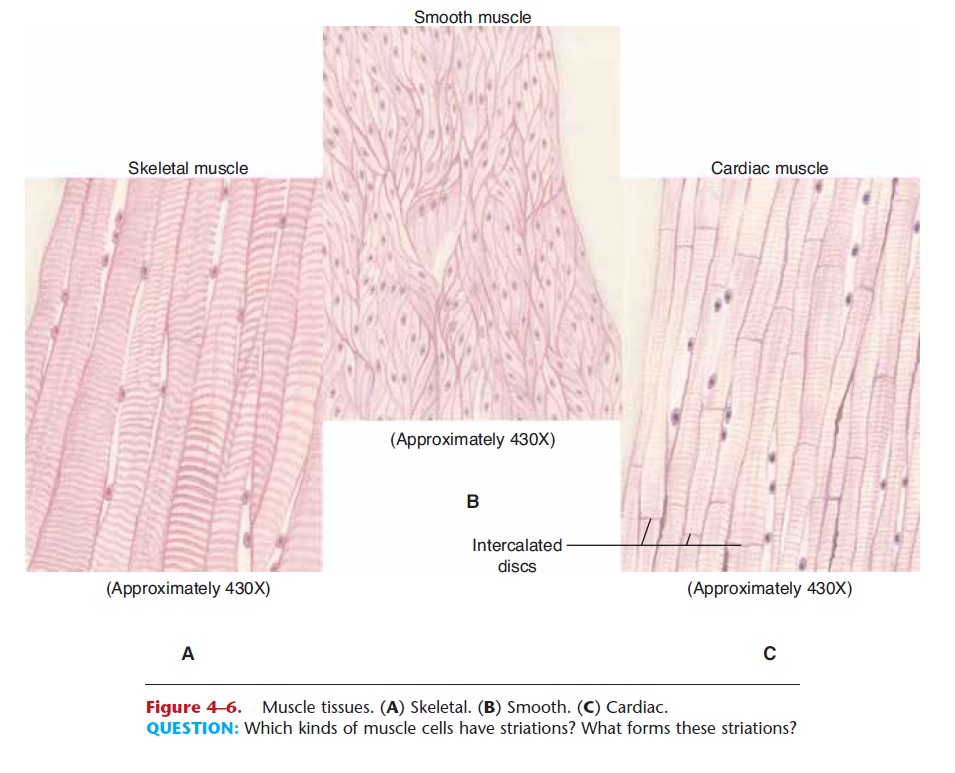Chapter: Essentials of Anatomy and Physiology: Tissues and Membranes
Muscle Tissue

MUSCLE TISSUE
Muscle tissue is specialized for contraction. When muscle cells contract, they shorten and bring about some type of movement. There are three types of muscle tissue: skeletal, smooth, and cardiac (Table 4–3). The movements each can produce have very different purposes.

SKELETAL MUSCLE
Skeletal muscle may also be called striated muscle or voluntary muscle. Each name describes a particular aspect of this tissue, as you will see. The skeletal muscle cells are cylindrical, have several nuclei each, and appear striated, or striped (Fig. 4–6). The striations are the result of the precise arrangement of the contracting proteins within the cells

Figure 4–6. Muscle tissues. (A) Skeletal. (B) Smooth. (C) Cardiac.
QUESTION: Which kinds of muscle cells have striations? What forms these striations?
Skeletal muscle tissue makes up the muscles that are attached to bones. These muscles are supplied with motor nerves, and thus move the skeleton. They also produce a significant amount of heat, which is important to help maintain the body’s constant temperature. Each muscle cell has its own motor nerve ending. The nerve impulses that can then travel to the muscles are essential to cause contraction. Although we do not have to consciously plan all our movements, the nerve impulses for them originate in the cerebrum, the “thinking” part of the brain.
Let us return to the three names for this tissue: “skeletal” describes its location, “striated” describes its appearance, and “voluntary” describes how it functions.
SMOOTH MUSCLE
Smooth muscle may also be called involuntary muscle or visceral muscle. The cells of smooth muscle have tapered ends, a single nucleus, and no striations (see Fig. 4–6). Although nerve impulses do bring about contractions, this is not something most of us can control, hence the name involuntary. The term visceral refers to internal organs, many of which contain smooth muscle. The functions of smooth muscle are actually functions of the organs in which the muscle is found.
In the stomach and intestines, smooth muscle contracts in waves called peristalsis to propel food through the digestive tract. In the walls of arteries and veins, smooth muscle constricts or dilates the vessels to maintain normal blood pressure. The iris of the eye has two sets of smooth muscle fibers to constrict or Muscle tissue is specialized for contraction. When muscle cells contract, they shorten and bring about some type of movement. There are three types of muscle tissue: skeletal, smooth, and cardiac (Table 4–3). The movements each can produce have very different purposes. dilate the pupil, which regulates the amount of light that strikes the retina.
Other functions of smooth muscle are mentioned in later. This is an important tissue that you will come across again and again in our study of the human body.
CARDIAC MUSCLE
The cells of the heart, cardiac muscle, are shown in Fig. 4–6. They are branched, have one nucleus each, and have faint striations. The cell membranes at the ends of these cells are somewhat folded and fit into matching folds of the membranes of the next cells. (Interlock the fingers of both hands to get an idea of what these adjacent membranes look like.) These interlocking folds are calledintercalated discs, and permit the electrical impulses of muscle contraction to pass swiftly from cell to cell. This enables the heart to beat in a very precise wave of contraction from the upper chambers to the lower chambers. Cardiac mus-cle as a whole is called themyocardium, and forms the walls of the four chambers of the heart. Its func-tion, therefore, is the function of the heart, to pump blood. The contractions of the myocardium create blood pressure and keep blood circulating throughout the body, so that the blood can carry out its many functions.
Cardiac muscle cells have the ability to contract by themselves. Thus the heart maintains its own beat. The role of nerve impulses is to increase or decrease the heart rate, depending upon whatever is needed by the body in a particular situation.
Related Topics